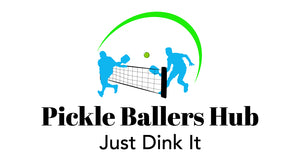Best Pickleball Paddles for Intermediates
Looks like you’re ready to take your pickleball skills to the next level, good work! This step up means it may be time for a new paddle designed for intermediates. But how do you know whether or not you’ve officially reached that “intermediate” level? If you are ready to shop, explore our Pickleball Paddles.
Pickleball players can find their skill level rating based on this scale below. These ratings are done on a scale of 1 – 5.5+, made based on mastery of control, consistency, and flexibility, with many other details falling into each of those sections. Intermediates in pickleball fall into the range of 3.0 – 4.0. Take a peek to see where you may fall in this range.
Rating |
Pickleball Rating System |
|
1.0-2.0 |
A rating of 1.0 - 2.0 is given if you are just starting to play pickleball & just starting to understand the |
|
2.5 |
A rating of 2.5 is given if you have limited experience playing pickleball. You can keep a short rally on |
|
3.0 |
A rating of 3.0 is given if you (A) can generally hit forehands, volleys, serves and returns with medium pace, |
|
3.5 |
A rating of 3.5 is given if (A) you can hit forehands, volleys, serves and returns with pace and moderate |
|
4.0 |
A rating of 4.0 is given if (A) you generally hit forehands and serves consistently with depth and control. You |
|
4.5 |
A rating of 4.5 is given if (A) you generally hit both forehand and backhand drives, serves, returns, dinks, drop shots, |
|
5.0 |
A rating of 5.0 is given if (A) you have mastered both forehand and backhand drives, serves, and returns with pace, |
|
5.5 |
A rating of 5.5+ is given if (A) you have mastered all shots and strategy on the court in |
Where Do I Start?
The size, shape, weight and material of a paddle all have an impact on the way you can play the game. It’s important to keep these aspects in line with where your growth is at. These differences can change the force behind your shots, the spin of the ball, and the control you have with each shot. Finding the right paddle for your skillset can be all it takes to make you a true force to be reckoned with on the courts.
We’re making it easy; take a look at the aspects you should look for in a paddle as an intermediate pickleball player.

What Aspects Should I Look for in an Intermediate Paddle?
PADDLE SIZE
Intermediate players can move onto standard or elongated sized paddles. Standard can also be used by beginners, but is still a fitting choice at the intermediate level.
- Standard Paddles
- 15 ¾” long
- 7 ½ – 8” wide
- They provide good combination of control and power
- They keep the paddle’s sweet spot on the larger size
- Elongated Paddles
- 16 ½” or longer (can be over 20” long)
- Generally 6 – 7 ½” wide
- Better for focusing on the power behind your shots
- The sweet spot will be a bit smaller and higher up than on a standard or short paddle
PADDLE THICKNESS
- Standard Paddles
- While thicker paddles give better control and a more comfortable sweet spot, standard paddles help keep a balance between control and power
- These paddles are around 14-15mm thick
- Typically weigh in the upper 7 to low 8 oz. range
- Thin Paddles
- Being lighter, thin paddles allow for more force behind shots which increases overall power
- One drawback is that shots hit outside of the sweet spot may not feel as comfortable
- These paddles are 13mm thick or less
- Typically weigh in the low to mid 7 oz. range
PADDLE SHAPE
The top two best paddle shapes for those entering the intermediate level are blade paddles and teardrop paddles.
- Blade Paddles
- Long and thin
- In essence these are elongated paddles, so about 16 ½” or longer
- As discussed before, this shape will increase the power in your shots
- They have a small but compact sweet spot
- This shape will require more skill to succeed, but if you are ready to level up your game and add some power to your shots, this is for you
- Teardrop Paddles
- Rounder shape
- Not as dramatic as a true “teardrop” shape, but they are slightly wider towards the top and a bit narrower towards the handle
- Their shape balances weight to extend the sweet spot further up top
- Rounder shape
- Long and thin
HANDLE LENGTH & GRIP SIZE
- Long Handle
- Better for controlling shots but are harder to maneuver overall
- If you want to start using two hands more in your shots for added power, a longer handle will benefit this play style
- Long handles are about 5-5 ½”
- Standard Handle
- Better for adding power to your shots and is easier to manage or maneuver throughout a game
- Standard handles are about 5” long
- Grip Size
- Grip size is measured as the circumference of the grip
- Your choice here mostly comes down to hand size, not so much skill level
- Smaller hands will benefit from smaller circumference grips. This saves you from burning energy in your hand or forearm while holding onto a larger grip.
- Larger hands will benefit from larger circumference grips for the same reason.
- The goal is to use whatever will permit the most comfort for your hand size – not too tight or too loose
- Thin grip size is 4-4 1/8”, standard grip size is 4 ¼”, and thick size is 4 ½ - ¾”
PADDLE MATERIAL
Since you’re entering the intermediate level of pickleball play, you can begin to do more with your shots. Different paddle materials will have an impact on what you’re able to do when hitting the ball. Some adding more spin while others help to increase power.
- Want more power?
- Use an Aluminum or Fiberglass paddle
- Want more control or spin on the ball?
- Use a Carbon Fiber or Graphite paddle
- Want to maintain a bit of everything?
- Hybrid paddles will provide a little bit of all shot effects
- Hybrid paddles are most often constructed with a combination of carbon fiber, fiberglass and graphite.
Our Top Intermediate Paddles for You
Now that you understand what makes the perfect intermediate pickleball paddle, we know that you're ready to start shopping. Don't worry, here at Pickle Ballers Hub we have built out a selection of the best pickleball paddles for intermediate players, making your shopping experience as easy as can be.


